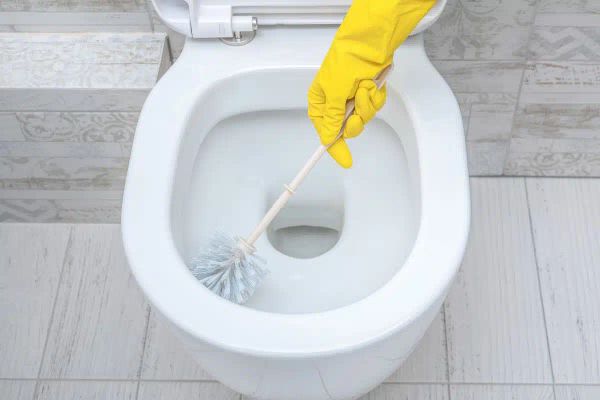
Cleaning toilets can be a tough task, especially when dealing with limescale buildup. These stubborn white deposits form due to hard water and can quickly become unsightly. But don’t worry, there’s a natural and effective solution that can remove limescale without the unpleasant smells of traditional cleaning products. Enter citric acid, a lesser-known yet powerful alternative to white vinegar.
Limescale builds up in toilet bowls due to the high levels of minerals in hard water. These deposits not only look bad, but they can also cause problems:
- Unsightly Appearance: Limescale stains make even clean bathrooms look dirty.
- Clogged Pipes: Limescale can accumulate in pipes, leading to blockages and reduced water flow.
- Health Concerns: Limescale provides a breeding ground for harmful bacteria, increasing the risk of hygiene-related health issues.
For years, people have used white vinegar to remove limescale. While it’s effective, it has some drawbacks:
- Strong Smell: The overpowering odor of vinegar can linger in the bathroom long after cleaning.
- Harsh Chemicals: Commercial cleaning products are effective but often harmful to health and the environment.
Citric acid is a fantastic eco-friendly alternative to vinegar and harsh chemicals. It’s a weak organic acid found in citrus fruits and is commonly used in the food and cosmetic industries. Here’s why it’s a great choice for limescale removal:
- Highly Effective: Citric acid can dissolve limescale efficiently.
- Odor-Free: Unlike vinegar, citric acid leaves behind a pleasant mild lemony scent.
- Non-Toxic and Environmentally Friendly: Citric acid is safe to use in the home, poses no threat to the environment, and breaks down easily.
Using citric acid is simple. Here’s a step-by-step guide:
Materials Needed:
- Citric acid powder
- Warm water
- A toilet brush
- A bucket or container
Step 1: Prepare the Citric Acid Solution
Mix an appropriate amount of citric acid powder with warm water in a container. The warm water helps dissolve the citric acid and enhances its cleaning power.
Step 2: Prepare the Toilet Bowl
Empty as much water from the toilet bowl as possible before applying the solution. This ensures direct contact with the limescale deposits.
Step 3: Apply the Solution
Pour the citric acid solution into the toilet bowl, covering all areas affected by limescale. Pay attention to the rim and any crevices where limescale tends to accumulate.
Step 4: Let It Sit
Let the solution sit for about 30 minutes for mild limescale or overnight for stubborn deposits.
Step 5: Scrub and Flush
After the waiting period, gently scrub away the limescale with a toilet brush. The citric acid will have weakened the deposits, making them easier to remove. Finally, flush the toilet to wash away any remaining residue.
Compared to other options, citric acid stands out for several reasons:
- Commercial Chemicals: Store-bought chemicals may be effective but often contain harmful substances that pose risks to health and the environment.
- White Vinegar: While vinegar is a natural solution, its strong odor can be off-putting. Citric acid is both odorless and equally effective, making it a more user-friendly option.
Citric acid is not only an excellent toilet cleaner but can also be used for other cleaning tasks:
- Descaling Coffee Makers and Kettles: Remove limescale buildup in appliances like coffee makers and kettles for efficient and long-lasting performance.
- Cleaning Stainless Steel: Remove water spots and stains from stainless steel surfaces without causing damage.
- Food Preservation: Citric acid is commonly used in cooking and food preservation, making it a versatile household product.
To make the most of citric acid for cleaning limescale, follow these tips:
- Proper Dilution: Always mix citric acid with water before use, as it’s a concentrated substance that could cause damage if used undiluted.
- Perform a Test: Test citric acid on a small inconspicuous area before applying it to large or visible areas to ensure no adverse reactions.
- Thorough Rinse: After using citric acid, always rinse the treated area well to remove any residue.
Citric acid is an excellent alternative to harsh chemicals and vinegar for removing limescale from toilets. Its powerful cleaning properties, along with its environmentally friendly and odor-free nature, make it a must-have in any home. By incorporating citric acid into your cleaning routine, you can keep your toilets sparkling clean, free from limescale, and hygienic – all without harsh chemicals or unpleasant smells. Give it a try and experience the benefits of using citric acid for toilet maintenance and more.



